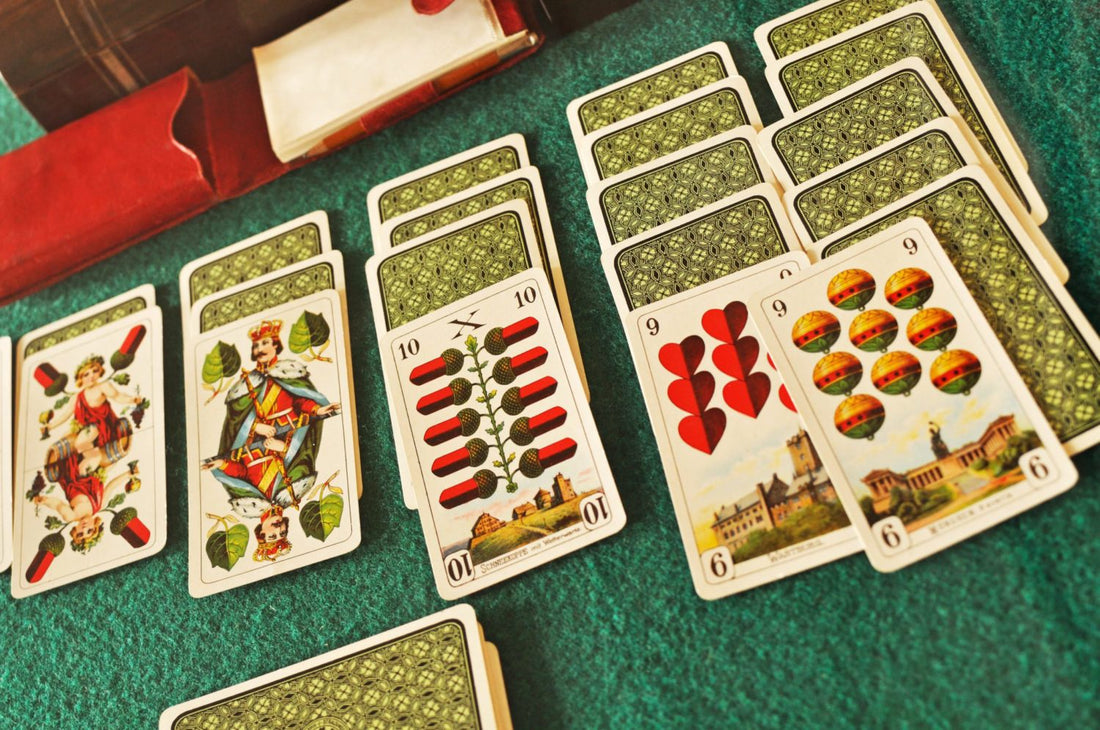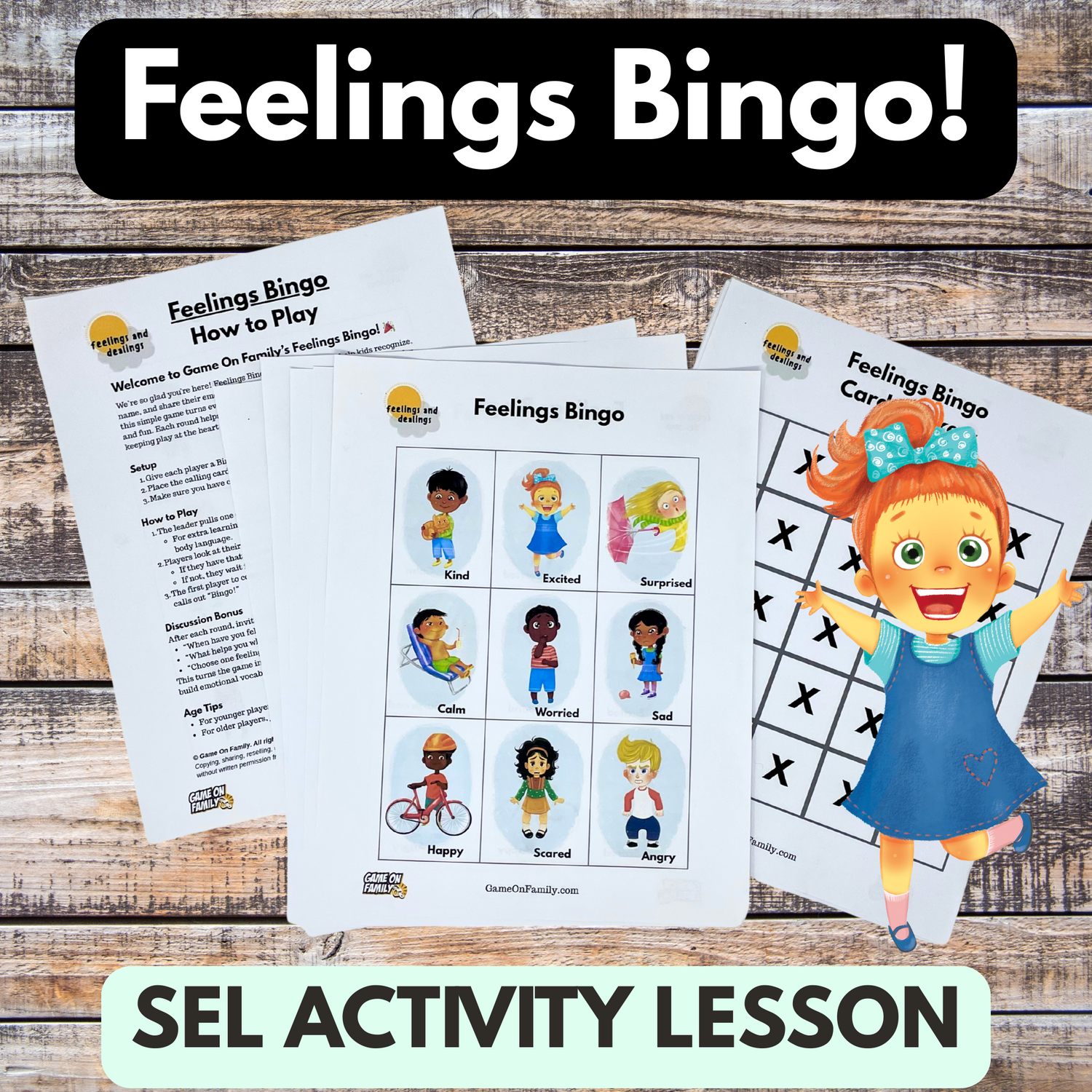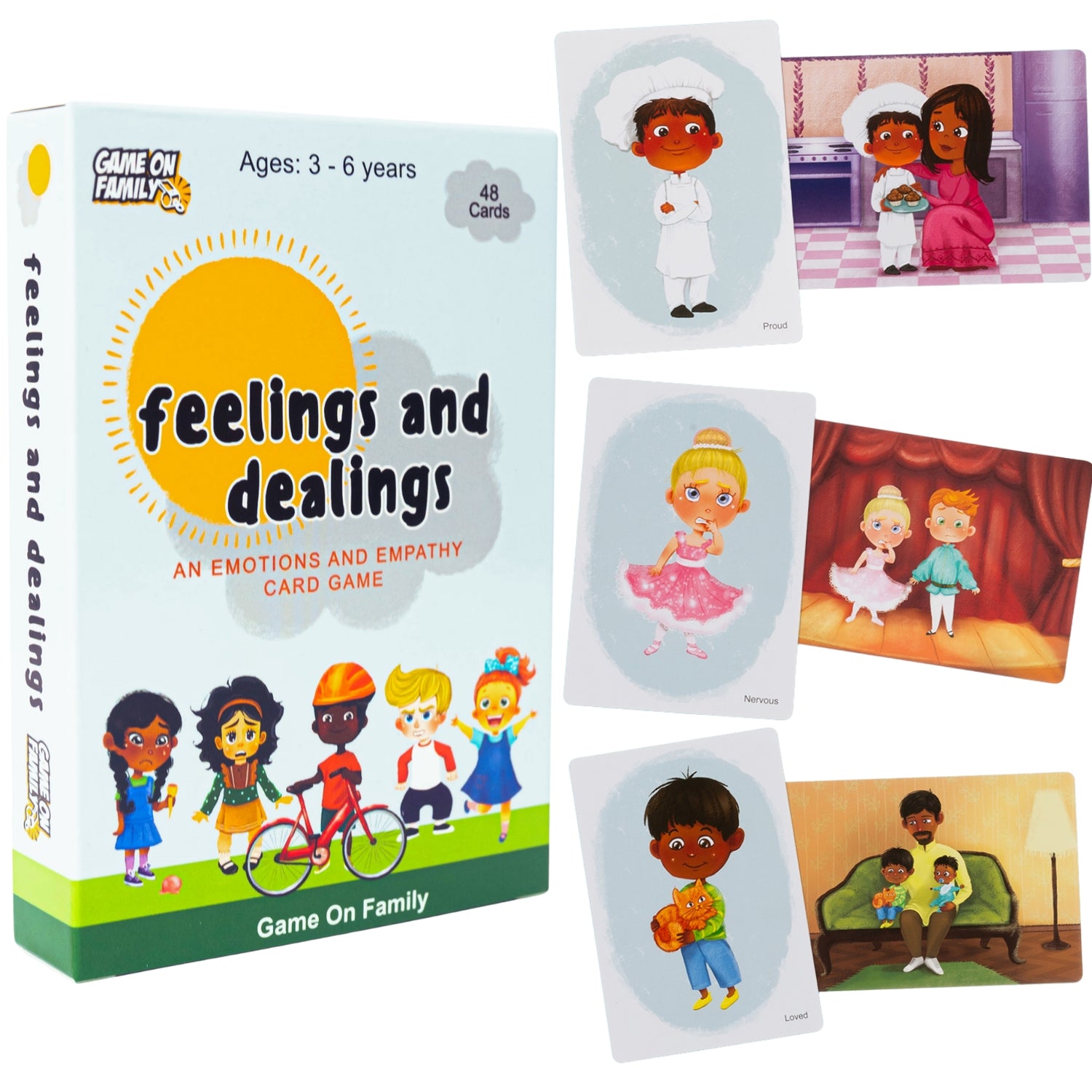
How to Play Solitaire (aka Patience)
Share
What is solitaire?
Solitaire (aka Patience in Europe) is a category of card-arranging games that are usually played by a single player. There are over 500 variations of solitaire games, but when someone says they’re “playing solitaire,” they’re usually talking about the “Klondike” version of the game that we’ll outline in this article. For other solitaire versions, see the “Solitaire Variations” section below.
What is Klondike solitaire?
Klondike Solitaire is a fun one-player sorting card game. Players attempt to move all of their cards from their 7-column stockpiles, draw, and waste piles to the 4 foundations piles. On the seven stockpiles, called the tableau, cards can only be moved onto a card that is one greater than the card being played, and of an opposite color. For example, if a card on the stockpile is the 7 of hearts (red), only the 6 of clubs or 6 of spades can be played on it. When cards are moved to each of the four foundation piles, they must be all of the same suit, in ascending order from Ace (low) to King (high).
Play Solitaire Online Free — Classic Klondike Version
Objective
Get all 52 cards onto the 4 foundation piles, with each foundation pile being of a single suit, and the cards ordered from Ace (low) to King (high).
Number of Players
1
Age
6+. The age range for solitaire varies a lot by the kid. In terms of math skills needed, they really only need to know the order of the 13 cards from Ace to King and know which is one higher or lower than a given number.
What you need
- Standard 52-card playing deck
- Playing surface
Skills
- Strategy: Players need to look at the pyramid and make decisions based on the placement of cards and what will open up different sections of the board.
- Math: Players use basic math skills such as number order.
Why we like Solitaire for kids and families
It’s great to have a single-player card game that your child can play instead of getting on a device! Plus, they’re using basic math skills as they attempt to order cards, as well as strategy skills to win the game.
How to Play Solitaire (Klondike)
When people say they’re going to play solitaire, they’re usually referring to the Klondike version. If you’d like to learn about playing other versions of solitaire, check out the Solitaire Variations section below.
1: Grab a deck of cards and find a playing surface
All you need to play solitaire is a single person (you), a standard 52-card deck of playing cards, and a surface to play on.
2: Set up solitaire by dealing the cards into 7 ascending columns and keep the rest as a “draw” deck
To set up the solitaire game, follow these 3 steps:
2a: Shuffle a standard 52 card deck
Shuffle the deck of cards so that they are mixed up at random.
2b: Deal the cards to form 7 ascending columns called “tableau piles”
The final setup of tableau piles will have 7 columns, with the first column having one card and each subsequent column to the right having one additional card, so that the 7th column has 7 cards. The top card in each pile will be face up and the cards below it will be face down. To deal the solitaire setup, lay seven cards down in a horizontal row from left to right in ascending piles. The first card will be face up and the remaining card will be face down. Continue laying down seven rows of cards, but on each new row, skip one additional column for your starting card, which is placed face up, then the remaining columns face down. In the end, the first pile will have one card, the second two cards, etc.
2c: Place the remaining card on the table in a face-down “draw” pile
Put the remainder of the deck to the side, face-down. This pile is called the draw deck (or stockpile) Your solitaire game is now ready to play!
3: Play the board with the goal of moving all cards to the 4 foundation piles
While the goal of solitaire is to get all of the cards into the four foundation piles (one for each suit, in ascending order), the challenge is that many of the cards needed to solve the game are trapped in the tableau, draw pile, and waste pile. So players must move cards around in an attempt to reveal and play more cards. Here are the three types of cards you can move:
3A: Play the Foundation pile
The goal of solitaire is to get all of the cards to the 4 foundation piles. Each foundation pile will only have cards from a single suit in it, and the cards must be ordered from lowest to highest (Ace, 2, 3…King) and can be played from either the waste pile or the tableau.. Cards in the foundation pile can also be played back down to the tableau, if needed.
3B: Play the tableau piles
Most of your moves will happen in the 7 tableau piles as you move cards around. When moving cards, the following rules apply:
- Cards may only be placed on top of each other in descending order, with alternating colors.
- The lower card, or run of cards, is moved on top of the higher card in another tableau.
- You cannot move the higher card or run underneath the lower card or run.
- When face up cards are moved out of a column and there are only face down cards remaining, flip the top card over to be face up and it is now playable.
- If a column is empty, only a King may be moved to fill that spot.
- You cannot have more than 7 tableau stacks
- Cards in the tableau can be moved to the foundation piles as long as they follow the rules of foundation piles (single suit per pile, in ascending order).
3C: Play the Draw deck & waste pile
Draw decks cards are flipped over, 3 at a time (unless playing 1-card solitaire) into the waste pile to create opportunities for more playable cards. When playing the draw deck and waste pile, the following rules apply:
- Cards are flipped, 3 at a time, from the face-down draw deck to the face-up waste pile so that all 3 cards are visible
- Only the top card in the waste pile is playable
- The top card in the waste pile can be played to either the foundation piles or the tableau piles, as long as they follow the rules of the foundation (ascending, same suit) and tableau (descending, opposite colors)
4: Continue play until you win or no other moves are possible
You win if you get all your cards to the 4 foundation piles (ordered A-K in matching suits) You lose if any cards are not in the four foundation stacks
Klondike Solitaire Video Tutorial
How to win at solitaire | 7+ Strategies to winning solitiare
The strategies for solitaire vary depending on the rules.
Three card solitaire, unlimited waste pile turns
This is the classic game that we’ve outlined in this article. The “three card” aspect of the game makes it more complex because, with three cards being flipped, playing a move from the waste pile changes which cards will be playable in the next waste pile turn. This means that there is a focus on both clearing cards from the waste pile as well as clearing cards from the tableau piles. Here are some general strategies for three card solitaire:
- Cycle through the entire draw deck before playing. If you’re playing where you can cycle stockpile unlimited times, might as well take a look to see what you have! Access to Aces will be a key component of the game. You’ll also get to see what other cards may be available (or hard to get to). If you’re not playing with unlimited draw deck cycles, do not use this strategy.
- Before making your first move, flip over the first 3 cards from the draw deck. Flip over three cards from the stockpile to form a “waste pile” that has the three cards stacked, but all still visible. Only the top card will be playable. While technically you can play the board before flipping over the first stockpile cards, strategically it’s better to see all your options before playing.
- Assess the board. Before playing, you should assess the board. You should consider the following all playable pieces before making your first move. Aces and Kings will be important to identify as Aces are key for the foundation piles and kings can block your board. Also look at what cards are currently playable, or what could be playable, by identifying cards in sequence with alternating colors.
- Play Aces and 2s immediately to the foundation piles. If you see an Ace, immediately play it to the foundation pile. Also, if a 2 is playable and it’s Ace is already in the foundation pile, immediately play the 2 to the foundation pile since there is no strategic advantae of having a 2 on the board (i.e. no card can be played on top of a 2).
- Play the foundation piles even, if possible. Keeping the foundation piles roughly even ensures that lower cards don’t get trapped on the board. You probably won’t be able to do this all game, but it’s a good general strategy.
- Generally play to lower the largest tableau stack. Your goal is to reveal as many cards as possibly, so you should attack the largest of the 7 tableau piles. The exception is if a King is covering cards on the board.
- Play to lower the shortest tableau stack if a King is on the board on top of other cards. A king on top of a tableau stack will block the cards beneath it. When this happens, you should attack the shortest tableau pile so that you can more easily move that king (it’s the only way to move it).
One card solitaire, unlimited waste pile
When you’re flipping every card from the draw deck onto the waste pile, instead of three at a time, the game is much easier to solve and your strategies should change. With this version, your strategy should shift from clearing both the tableau and waste pile, to just focus on clearing the 7 tableau piles. This is because you will always have access to every card in the draw deck / waste pile by cycling through again. You can also cycle through to peek at upcoming cards with no risk.
Other
- Limited waste turns: If you’re playing with a limit on the number of times you can cycle through the draw deck and waste pile, you probably shouldn’t cycle through them just to look at the cards.
- Online undo button: Some people, when playing the online game, will play a bunch of cards with the intent of looking at future cards, and then use the undo button to step backwards. This is a for sure a strategy, but not how the game was intended to be be played.
12 Solitaire Rules
Game End
- The game is won when all of the cards have been moved to the 4 foundation piles, with only a single suit being in each of the four foundation piles, and all cards being played in ascending sequence from Ace to King
- The game is over if there are no more moves that can be made
Foundation
- Each of the four foundation piles can only contain one suit
- The foundation piles are stacked from lowest (Ace) to highest (King)
- Cards in the foundation can be moved back down to the tableau as long as they are in sequence
Draw deck and waste piles
- Cards from the draw deck are flipped three at a time (unless you’re playing the easier, single-flip variation, with all 3 cards visible
- Cards from the waste pile can be played to either the tableau or foundation piles, as long as they follow the sequence and suit rules
- When you run out of cards in the draw deck, flip the waste pile over, without shuffling, to form a new draw deck
Tableau piles
- Cards in the tableau stacks must be descending and alter colors (red/black)
- Only kings can move to a empty tableau pile
- Individual cards, or runs, can be moved to a new column of a higher number, so that the the connecting cards still follow the rules of the descending sequence and alternating colors
- Higher cards/runs cannot be moved under the lower column
Solitaire Variations
Variations for Klondike solitaire
- One card solitaire: In this version, you don’t do three cards flipped at a time from the draw deck to the waste pile. This makes the game easier, and also changes the strategy, as outlined in the strategy section above.
- Limit on waste pile cycles: Some people (or casinos) will limit the number of times you can cycle through the draw deck / waste pile. This changes the strategy, as well as the probability of winning the game.
Other types of solitaire
There are over 500 variations of solitaire, and while the Klondike version is so common that it’s often just called “solitaire,” there are many other popular versions. Some of the most popular variations include:
Spider Solitaire
This two deck, 8 foundation (for the 8 spider legs) game has roughly a 1/3 change of winning.
Free Cell Solitaire
The free cell version of solitaire is popular and included as a default game on many computers. It is strategic, and most boards can be solved.
Pyramid Solitaire
Pyramid solitaire, in it’s most strict form, is one of the hardest games to win (1 in 50), but with a minor rule variation, as we outline here, is much more reasonable. It can also be modified to be a great math game for kids.
Double Solitaire
This is really just a 2 deck version of the Klondike, but played with 9 tableau stacks instead of 7.
Tri Peaks Solitaire
The tri-peaks version of solitaire forms 3 peaks of cards and is roughly 90% solvable.
Solitaire Glossary
- Draw Deck / Stockpile: The deck remaining after setup is complete. These cards will be flipped over 3 at a time into the waste pile, to reveal more playable cards.
- Waste Pile: Cards from the draw deck are flipped 3 at a time into the waste pile, and the top card is playable either into the tableau or the foundation piles.
- Tableau: The 7 piles of cards, placed in columns, that form the main play area.
- Foundation piles: The goal of the game is to move all of the cards to 4 separate “foundation” piles in ascending order from Ace (low) to King (high) in matching suits. The 4 foundation piles are typically placed above the 7 tableau piles.
Solitaire FAQs
Here we’ll be answering questions about the Klondike version of solitaire outlined in this article, unless otherwise noted.
How to Play
How do you play solitaire?
Solitaire is played in four simple steps, and is outlined more fully in the lesson above:
- Set up the game by shuffling and dealing the cards into 7 stacks
- Flipping cards from the draw pile
- Playing sequential, descending cards in the 7 tableau columns
- Moving cards to the the four, suit based “foundation” piles in ascending order
How to play solitaire for beginners
The Klondike solitaire game can easily be played by following the standard instructions as listed above. One modification to make the game easier for beginners is to flip over one card from the stockpile at a time instead of three.
How to play solitaire for kids
The game of solitaire is fine for kids eight and up. To make the game easier, they can flip over every card instead of every three cards. Also, there are some variations of the game, such as 7-up that are easier to play.
How to play solitaire by yourself
Most solitaire games are one player games, so just follow the instructions above.
How to play solitaire with a deck of cards
If you’ve only played solitaire online, you may not know how to set up the game. The full explanation is in the tutorial above, but to summarize:
- Shuffle a standard deck of playing cards
- Deal seven ascending piles of cards, one at a time, so that the first pile has 1 card, the second has 2 cards, etc and make sure the top card of each pile is face up
- The remaining cards form your stockpile / draw deck, and are placed face down
- You’re now ready to play!
What is a run in solitaire?
A run in the most popular solitaire game, Klondike, is any number cards in a column that are descending sequentially by rank, and alternating colors.
How does solitaire work?
Solitaire is an ordering game with the goal of getting all of the cards into the four, suit based, foundation piles from the lowest (Ace) to highest (King).
Setup
How do you set up solitaire? | How to deal solitaire
Once your 52 card deck is shuffled, you’re ready to deal the cards. You’ll be dealing the cards to form 7 columns. To form the first row of cards, starting from left to right, deal one card face up in the first column, then one card face down to form columns two through seven. To form the second row, start from the second column and deal one card face up and the remaining to the right face down. Continue dealing by starting each row one spot to the right, face up, and the remaining cards face down. When you are done, you should have formed 7 columns, with the number of cards matching the column number (1 in column 1, 2 in column 2, etc) and the top card in each stack face up (with the cards under it face down).
How to start solitaire
To start solitaire, first shuffle a standard 52-card deck to randomize the cards. Then form seven columns of cards with one card in the first column, two in the second, and one in each subsequent column to the right so that the 7th column has 7 cards in it. The top card in each column should be facing up and all other cards are face down. The remaining cards will be face down in a single stack called the stockpile. While officially, the game is now ready to start and you can play anything on the board, you should first flip over the first three cards of the stockpile so that you can see all of your options before playing.
How many cards in solitaire?
Solitaire is played with a standard 52-card deck, without any jokers. 28 cards will be dealt out in the 7 tableau piles and the remaining 24 cards will form the stockpile.
How many columns / piles / rows are in solitaire?
There are seven columns of cards in solitaire to form the tableau. Cards are dealt to form ascending piles so that the first tableau column has one card, the second has two cards, etc. There is also a draw deck, and four foundation piles.
What is the foundation in solitaire?
The foundation is solitaire is the goal area of the game. There are four foundational piles, one for each of the suits, but no cards are initially dealt into the foundation piles. Once an ace is playable, it can be moved to form the foundation pile for that suit. Cards are played sequentially on top of that, of matching suits, from Ace (low) to King (high). The game is won when all cards have been played to the foundation piles.
How many stacks in solitaire?
7 columns form the tableau in solitaire. There is also a draw deck stack, a waste pile stack, and four foundation piles.
About
What is solitaire?
Solitaire, also called Patience in Europe, is a category of mostly one-player games most commonly played with cards (but can also be played with dominoes, marbles, or pegs). While many versions of solitaire exist, the Klondike card game version of solitaire is the most popular game, and if someone says they are going to “play solitaire,” they are most likely referring to the Klondike version.
What does solitaire mean?
The game solitaire is derived from the latin word “solitarius,” which means alone, solitary, or isolated. Solitaire is a broad game category that includes mostly one-person card games, as well as some domino, marble, and peg games.
History
When was solitaire invented?
While the exact creation date of the solitaire game is unclear, there is evidence in literature in the 1700s of the game's existence. The most popular version of solitaire today, known as “Klondike” or “Canfield” solitaire, was created in the late 1800s in either Canada or the United States. Starting in 1990, Microsoft included the Klondike version of solitaire with the Windows operating system, which greatly boosted the popularity of the game.
Who invented solitaire?
It’s unclear who invented the original version of solitaire, but it’s believed that it was invented in the 1700s in northern Europe. The popular “Klondike” solitaire (aka Canfield) was likely created as a casino game in the Klondike area of Canada. Some people think Richard Canfield was the creator of the game, but he referred to the game as Klondike, so it’s unclear.








